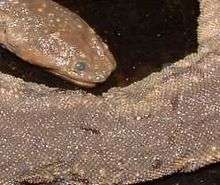Elephant trunk snake
| Elephant trunk snake | |
|---|---|
 | |
| Scientific classification | |
| Kingdom: | Animalia |
| Phylum: | Chordata |
| Subphylum: | Vertebrata |
| Class: | Reptilia |
| Order: | Squamata |
| Suborder: | Serpentes |
| Family: | Acrochordidae |
| Genus: | Acrochordus |
| Species: | A. javanicus |
| Binomial name | |
| Acrochordus javanicus Hornstedt, 1787 | |
Acrochordus javanicus, commonly known as the elephant trunk snake or Javan file snake, belongs to the Acrochordidae family which represents a group of primitive non-venomous aquatic snakes. It is also kept as an exotic pet.
Description
Acrochordus javanicus possesses a wide and flat head, nostrils situated on the top of the snout. Those head's particularities confer to Acrochordus javanicus a certain resemblance with boas. However, its head is also wide as the body. Females are bigger than males and the maximum size of an individual is 240 cm. The dorsal side of the snake's body is brown and its ventral side is pale yellow.[2]
The skin is baggy and loose[3] giving the impression that it is too big for the animal. The skin is covered with small rough adjacent scales. The skin is also used in the tannery industry.[1][2]
These snakes are fully adapted to live underwater so much that their body cannot support their weight out of water and leaving the water can cause them serious injury.
These aquatics snakes are ovoviviparous, the incubation lasts 5 in 6 months and the female expels from 6 to 17 young.[1]
Distribution
Acrochordus javanicus is found in South-East Asia west of the Wallace Line:[1] southern Thailand, the west coast of Peninsular Malaysia, Singapore, Borneo (Kalimantan, Sarawak), a number of Indonesian islands (Java, Sumatra, and (possibly) Bali);[1][4] possibly also in Cambodia[5] and Vietnam,[4][5] although the last is discredited by the IUCN.[1]
Habitat
Acrochordus javanicus has a coastal living habitat like rivers, estuaries and lagoons. But it prefers freshwater and brackish environments.[2]
Feeding
Acrochordus javanicus is an ambush predator that likes to capture fishes and amphibians. It usually catch its preys by folding firmly its body around it. Its loose, baggy skin and its sharp scales find their utility by limiting any risk of escape of the prey, in particular fishes which body is covered with a viscous protective mucus.[2]
Behavior
Acrochordus javanicus is active at night. It spends most of its life under water and rarely goes on land. It can stay under water up to 40 minutes.[2]
Original Publication
- Hornstedt.Beschryving van een nieuwe slang van Java.. Kungliga Svenska vetenskapsakademiens handlingar,1787,vol.4, p. 307.
References
- 1 2 3 4 5 6 Sanders, K.; Grismer, L. & Chan-Ard, T. (2012). "Acrochordus javanicus". IUCN Red List of Threatened Species. Version 2014.3. International Union for Conservation of Nature. Retrieved 17 February 2015.
- 1 2 3 4 5 Chiu, K. (1999). "Acrochordus javanicus Javan File Snake, Elephant Trunk Snake". Animal Diversity Web.
- ↑ Durso, Andrew (30 August 2014). "Filesnakes, Wartsnakes, or Elephant Trunksnakes". Life is Short, but Snakes are Long. Retrieved 27 February 2016.
- 1 2 Van Wallach; Kenneth L. Williams; Jeff Boundy (22 April 2014). Snakes of the World: A Catalogue of Living and Extinct Species. CRC Press. pp. 6–7. ISBN 978-1-4822-0848-1.
- 1 2 Acrochordus javanicus at the Reptarium.cz Reptile Database. Accessed 27 February 2016.
External links
- Acrochordus.com
- http://www.marinespecies.org/aphia.php?p=taxdetails&id=344014
- http://www.ncbi.nlm.nih.gov/Taxonomy/Browser/wwwtax.cgi?lin=s&p=has_linkout&id=39267
- Javan Filesnakes at Life is Short but Snakes are Long
